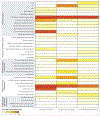Risk and protective factors for childhood suicidality: a US population-based study
- PMID: 32171431
- PMCID: PMC7456815
- DOI: 10.1016/S2215-0366(20)30049-3
Risk and protective factors for childhood suicidality: a US population-based study
Abstract
Background: Childhood suicidal ideation and behaviours are poorly understood. We examined correlates of suicidality in a US population-based sample of children participating in the Adolescent Brain and Cognitive Development (ABCD) study. The ABCD study aims to examine trajectories of mental health from childhood to adulthood and collects information on multiple domains, including mental and physical wellbeing, brain imaging, behavioural and cognitive characteristics, and social and family environment. We sought to identify and rank risk and protective factors for childhood suicidal thoughts and behaviours across these multiple domains and evaluate their association with self-agreement and caregiver agreement in reporting suicidality.
Methods: The ABCD sample comprises a cohort of 11 875 children aged 9-10 years. The sociodemographic factors on which the sample was recruited were age, sex, race, socioeconomic status, and urbanicity. Participants were enrolled at 22 sites, the catchment area of which encompassed over 20% of the entire US population in this age group. Multistage sampling was used to ensure both local randomisation and representativeness of sociodemographic variation of the ABCD sample. The data used in this study were accessed from the ABCD Study Curated Annual Release 2.0. Suicidal thoughts and behaviours (suicidality) in each child were evaluated through independent child and caregiver reports based on the computerized Kiddie Schedule for Affective Disorders and Schizophrenia for DSM-5 (KSADS-5). We used bootstrapped logistic regression to quantify the association between suicidal ideation and behaviours, with measures of mental and physical wellbeing, behaviour, cognition, and social and family environment in participants from the ABCD study.
Findings: Our study sample comprised 7994 unrelated children (mean age 9·9 years [SD 0·5]; 4234 [53%] male participants) with complete data on child-reported and caregiver-reported suicidal ideas and behaviours. Overall, 673 (8·4%) children reported any past or current suicidal ideation, 75 (0·9%) had any past or current suicidal plans, and 107 (1·3%) had any past or current suicidal attempts. According to caregivers, 650 (8·1%) of the children reported any past or current suicidal ideation, 46 (0·6%) reported any past or current suicidal plans, and 39 (0·5%) reported past or current suicidal attempts. However, inter-informant agreement was low (Cohen's κ range 0·0-0·2). Regardless of informant, child psychopathology (odds ratio [OR] 1·7-4·8, 95% CI 1·5-7·4) and child-reported family conflict (OR 1·4-1·8, 95% CI 1·1-2·5) were the most robust risk factors for suicidality. The risk of child-reported suicidality increased with higher weekend screen use time (OR 1·3, 95% CI 1·2-1·7) and reduced with greater parental supervision and positive school involvement (for both OR 0·8, 95% CI 0·7-0·9). Additionally, caregiver-reported suicidality was positively associated with caregiver educational level (OR 1·3, 95% CI 1·1-1·5) and male sex in children (1·5, 1·1-2·0), and inversely associated with the number of household cohabitants (0·8, 0·7-1·0).
Interpretation: We identified risk and protective factors that show robust and generalisable associations with childhood suicidality. These factors provide actionable targets for optimising prevention and intervention strategies, support the need to identify and treat psychopathology in school-age children, and underscore the importance of school and family interventions for childhood suicidality.
Funding: National Institutes of Health.
Copyright © 2020 Elsevier Ltd. All rights reserved.
Figures


Comment in
-
Identifying suicide risk factors in children is essential for developing effective prevention interventions.Lancet Psychiatry. 2020 Apr;7(4):292-293. doi: 10.1016/S2215-0366(20)30094-8. Epub 2020 Mar 12. Lancet Psychiatry. 2020. PMID: 32171430 No abstract available.
References
-
- National Institute of Mental Health. Mental health information. Statistics. Suicide https://www.nimh.nih.gov/health/statistics/suicide.shtml (accessed Feb 5, 2020).
-
- Plemmons G, Hall M, Doupnik S, et al. Hospitalization for suicide ideation or attempt: 2008–2015. Pediatrics 2018; 141: e20172426. - PubMed
Publication types
MeSH terms
Grants and funding
- R01 MH100155/MH/NIMH NIH HHS/United States
- U24 DA041147/DA/NIDA NIH HHS/United States
- U01 DA051039/DA/NIDA NIH HHS/United States
- R01 MH080243/MH/NIMH NIH HHS/United States
- U01 DA041093/DA/NIDA NIH HHS/United States
- U24 DA041123/DA/NIDA NIH HHS/United States
- R01 MH11358/MH/NIMH NIH HHS/United States
- R01 MH113619/MH/NIMH NIH HHS/United States
- U01 DA041156/DA/NIDA NIH HHS/United States
- R01 MH067924/MH/NIMH NIH HHS/United States
- U01 DA041025/DA/NIDA NIH HHS/United States
- U01 DA041089/DA/NIDA NIH HHS/United States
- U01 DA041106/DA/NIDA NIH HHS/United States
- U01 DA041117/DA/NIDA NIH HHS/United States
- U01 DA041148/DA/NIDA NIH HHS/United States
- R01 MH116652/MH/NIMH NIH HHS/United States
- U01 MH116923/MH/NIMH NIH HHS/United States
- U01 DA041174/DA/NIDA NIH HHS/United States
- U01 DA041120/DA/NIDA NIH HHS/United States
- R01MH08024/MH/NIMH NIH HHS/United States
- U01 DA041134/DA/NIDA NIH HHS/United States
- R01 MH116147/MH/NIMH NIH HHS/United States
- U01 DA041022/DA/NIDA NIH HHS/United States
- S10 OD018522/OD/NIH HHS/United States
- S10 OD026880/OD/NIH HHS/United States
- F31 MH011358/MH/NIMH NIH HHS/United States
- P50 MH115838/MH/NIMH NIH HHS/United States
- U01 DA041028/DA/NIDA NIH HHS/United States
- U01 DA041048/DA/NIDA NIH HHS/United States
LinkOut - more resources
Full Text Sources
Medical
Miscellaneous

